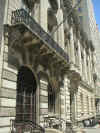 |
New York
Architecture Images-Upper East Side Lycee Francais De New York |
|
architect |
|
|
location |
9 East 72, Bet. Fifth And Madison Aves. |
|
date |
|
|
style |
|
|
construction |
limestone |
|
type |
House |
|
|
|
|
images |
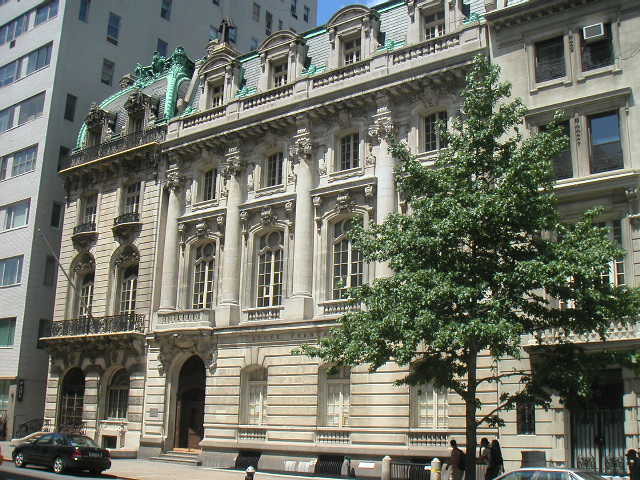 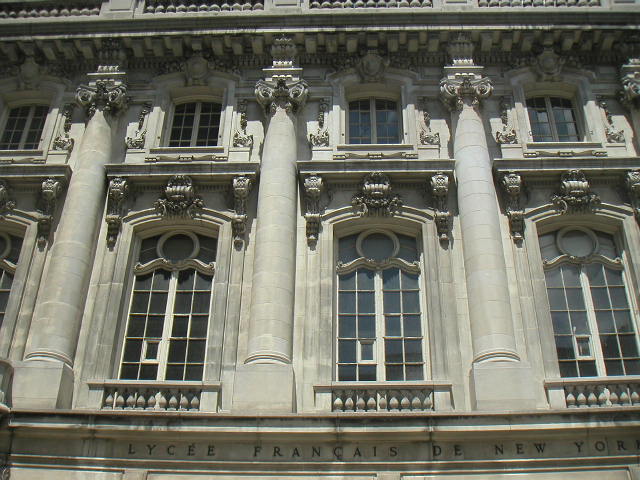 |
|
|
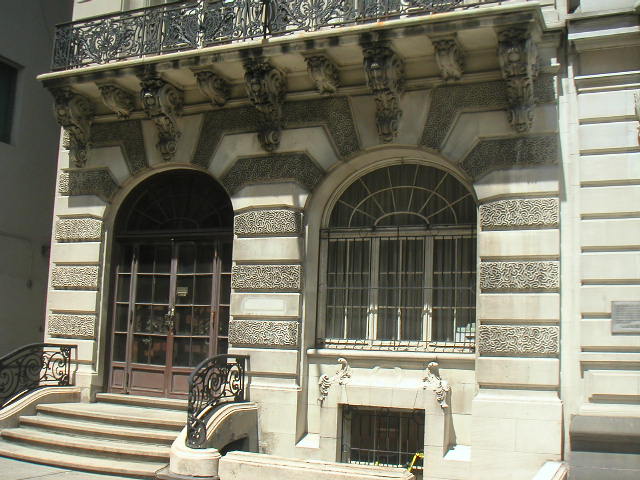 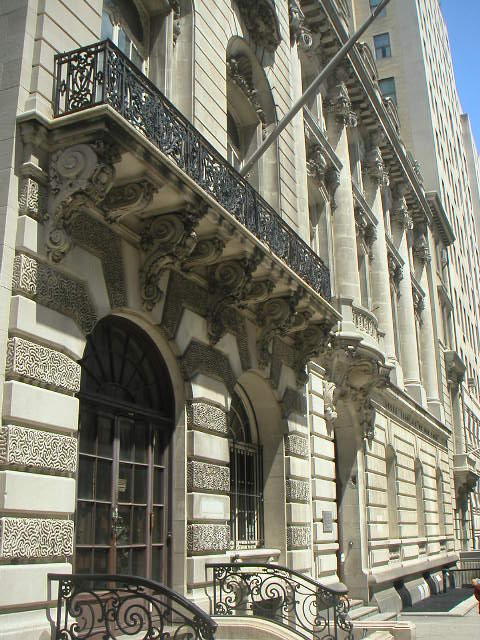 |
|
notes |
In 1957, the
Lycée Français built a three-story, white-brick annex on the Livingston lot,
at 5 East 95th Street, and earlier this year it was demolished for a new
building that will be joined to the old Carhart house at 3 East 95th Street.
Both will be as sold as condominiums by 95 LLC, a Hong Kong developer. Renderings of the new project, designed by the architects Zivkovic Associates and John Simpson & Partners, appear to show an unusual hybrid. The bulk of the new building is in a restrained French neo-Classical design, but a setback rooftop addition has a temple front, and the side elevation facing the House of the Redeemer has a Regency-style character, perhaps after the style of the 18th-century Scottish architect Robert Adam. The facade, of Indiana limestone, required approval by the Landmarks Preservation Commission. THE new building mimics the character of a large town house, but instead of responding to the Fabbri courtyard with one of its own, as envisioned by the 1914 restriction, the new portion of the condominium is being built out to the building line — like the white brick Lycée Français — right up against the old Fabbri property. |
| The Lycee is next door to the Edith and Ernesto Fabbri House | |
|
Need a Deal on a
Gym? Lycee Francais Pushes 6 Classroom Buildings - FinancialObserver New York Observer, The, Feb 12, 2001 Byline: Deborah Schoeneman and Deborah Netburn Sharon Baum, a broker with the Corcoran Group, stepped out of her chauffeured Rolls-Royce in front of 9 East 72nd Street on the afternoon of Feb. 5., a rhinestone pin that read "SOLD" sparkling on her lapel. Ms. Baum headed inside the Beaux Arts mansion, one of six Upper East Side townhouses, spread out over three locations, that comprise the Lycee Francais de New York, a bilingual school started in 1935. Just three days earlier, the Lycee had hired Ms. Baum and her colleagues at Corcoran to sell the buildings, thereby replacing Massey Knackal Realty, the firm that has been marketing the properties since last August. Ms. Baum's first step was to begin referring to the string of buildings as "The Lycee Collection": They include Nos. 7 and 9 East 72nd Street, priced at $21 million and $30 million, respectively; 3 and 5 East 95th Street, priced at $19.5 million and $10.3 million, respectively; 60 East 93rd Street, priced at $17 million; and, finally, 12 East 73rd Street, priced at $8 million. Her second step will be to slash the prices almost 20 percent on Feb. 8. The school has also hired a spokesman, Howard Rubenstein, who said that the change in representation reflected a lesson learned over the past six months. He said the school had switched from Massey Knackal, a primarily commercial real estate firm, to Corcoran, a primarily residential firm, because most of the interest in the properties has been from people who wanted to return the buildings to individual homes. The Lycee has had "an enormous number of people coming to look at the buildings and inquire," said Mr. Rubenstein. "Seventy percent of those people want the buildings for residential use." Mr. Rubenstein also said that the Lycee thought Corcoran could better reach possible overseas buyers. Ms. Baum said that she and Carrie Chang, another Corcoran broker, are marketing the properties around the world to individuals, institutions and developers who could turn the mansions into apartments. Mr. Rubenstein said the Lycee has turned down some offers, but it now seems as though the buyers are the ones who are balking, turning down the school's high prices. "My sense is that Lycee is getting anxious," said one townhouse expert about the school's having switched real estate firms. "I had heard that they had a $43 million offer for the two buildings on 72nd Street. They should have run screaming to the bank." The broker said the rejected offer was made by a foreigner who wanted to turn the townhouses into a foundation. In November, New York magazine reported that Band-Aid heiress Libbet Johnson was close to a deal to buy the six mansions. The report said she planned to live at 9 East 72nd Street (known as the Sloan Mansion) and sell off the other buildings. "That was just a rumor," said Ms. Baum. But two of the properties have offers on the table now, one made by an individual and one by an institution, she said. The de-institutionalizing of the mansions of New York-especially those on the Upper East Side-has been going on for the last couple of years, and is gaining as the de rigueur move in real estate. The buildings are being renovated back into individual residences. One of the first significant purchases was that of New York investor Bruce Kovner, who paid $17.5 million in November 1999 for the uptown outpost of the International Center for Photography, on the corner of Fifth Avenue and 94th Street. (The museum has still not vacated the building.) A year later, socialite Sloan Lindeman spent $11.25 million on the English Speaking Union, a 33-foot-wide mansion at 16 East 69th Street that had been the union's headquarters for 44 years. And on Dec. 6, a 40-foot-wide house at 10-12 East 94th Street that housed the offices of Louise Wise Services, an adoption agency, was purchased by Nicholas Rohatyn, son of the former ambassador to France, for $7.4 million. Comparatively, the Lycee properties are treasures, but aside from being overpriced, they will be extremely difficult to un-renovate. A typical floor plan includes a biology lab, a nurse's office and a dining room. Then again, the grand staircases have been retained, and there are spaces with designations like "Salle d'Honneur" and "The Marble Room." The school, which currently enrolls 970 kids from preschool to the 12th grade, started at the two buildings at 3 and 5 East 95th Street. The five-story house at 3 East 95th Street was built in 1921 in the 18th-century French style and was purchased by the Lycee in 1937. The three-story building at 5 East 95th Street was constructed the same year, after the school bought a garden from a neighbor. Ms. Baum showed the latter property on Feb. 2. In 1964, the Lycee bought the two buildings at 7 and 9 East 72nd Street, which now house the preschool-through-elementary-school facilities. Built in 1896 for Henry T. Sloan, a carpet upholsterer, 9 East 72nd Street is the prize among the properties: It's 59 feet wide, has five stories and boasts approximately 25,363 square feet. The neighboring five-story house at 7 East 72nd Street, which was built in 1899 for Oliver Gould Jennings, director of the National Fuel Gas Company, is 28 feet wide, with a limestone facade, large French windows and a total of 18,256 square feet. As Ms. Baum walked through the mansions, which have been joined, she pointed out marble fireplaces and ornate original moldings. The Sloan Mansion is the largest townhouse to go on the market since the Vanderbilt Fabbri Mansion at 11 East 62nd Street, which Ms. Baum sold to the Japanese government for $21.5 million in December 1998. That mansion had been the headquarters of the Johnson O'Connor Research Foundation, an aptitude-testing center, for 55 years. Michael Jackson was the only individual who seriously considered buying it. In 1978, the Lycee bought its fifth building, formerly known as the Virginia Graham Fair Vanderbilt house, at 60 East 93rd Street. They paid $680,000. Finally, in 1994, the school bought 12 East 73rd Street, a five-story townhouse built in 1920, for $4.3 million. It has been connected to the mansions on 72nd Street. Richard Speciale, a financial adviser to the Lycee, said the school's decision to vacate the townhouses was based on a drive to improve the academic environment rather than to raise cash. "They came to a truly emotional decision to leave the premises," said Mr. Speciale. "The single best way to re-invigorate the program at Lycee was to find another site and build a facility designed for an academic purpose." Mr. Speciale said a new facility was a more cost-effective alternative to renovating the townhouses. The Lycee bought a site on York Avenue between 75th and 76th streets in January and is in the process of building a new school, which it plans to open in the fall of 2002. They're hoping Ms. Baum will help them sell their other properties well before then. |
|
|
Streetscapes/ East 93rd Street Between
Madison and Park Avenues; Where City's Stately Mansions Made a Last
Stand By CHRISTOPHER GRAY Published: September 29, 2002, Sunday THE world changed forever -- after the stock market crash of 1929. And one of the biggest changes was the end of the era of large mansions on the Upper East Side, as even the richest families found irresistible the convenience and economy of apartment living. But on 93rd Street between Madison and Park Avenues, several families sought to make a last stand of elegance. Now new owners are taking over two of the mansions. This block of 93rd was nearly empty in 1888 when its oldest buildings went up, the row houses at 57 and 61 East 93rd. Then in 1891 came the small apartment buildings at 62 to 72 East 93rd. In 1900 the developer Frederick Kilpatrick built the more expansive Alamo apartment building at 55 East 93rd, which offered apartments of 5 to 12 rooms. By this time the block had filled up with other modest buildings, hardly the company that the mansions' builders, who were filtering up Fifth Avenue, would like to keep. One big house did go up on the northwest corner of 93rd and Park, built in 1917 by the financier Francis F. Palmer and designed by Delano & Aldrich, but the nearly cubic Georgian-style house related to the growing stature of Park Avenue, not to 93rd Street. Down in Murray Hill, the banker George F. Baker, head of National City Bank and one of the richest men in the country, was fighting apartment and loft developers who sought to build high-rises that would overshadow his mansion at Madison near 39th. Baker, who oversaw a family complex that included a house for his in-laws, the Loews, faced the unpleasant prospect of buying up parcel after parcel as other householders fled to Midtown and farther north. He kept on, but the younger generation did not. In 1927, George F. Baker Jr. left the Murray Hill enclave and bought the old Palmer mansion at 93rd and Park. The younger Baker brought back Delano & Aldrich to add a ballroom to the main houseand to design a smaller house at 67 East 93rd and a garage at 69 East 93rd, all in complementary style. The son's uptown defection spread, and in 1930 his sister and brother-in-law, Florence and William Goadby Loew, bought the properties at 54 to 58 East 93rd, They retained Walker & Gillette to design a sumptuous, Regency-style limestone house at 56 East 93rd, with a distinctive, inward-curving facade. Building records indicate it was for ''the owner, his wife and 16 servants.'' In the same year, Virginia Vanderbilt, divorced in 1927 from William K. Vanderbilt Jr., bought the buildings at 60 to 64 East 93rd Street. To replace them, she had the architect John Russell Pope design a French classic house of 51 rooms. It is likely that Mrs. Vanderbilt was more than just casually friendly with the Bakers and the Loews. In 1920 she gave a dinner at her Fifth Avenue mansion for the Loews' daughter, Evelyn. The ''new residential colony,'' as The New York Times put it in 1930, ran counter to the decline of the large private house in New York, and that year marked the last boom for such dwellings. Plans for five in all of Manhattan were filed at the Department of Buildings that year, and the few built after the Depression never again rivaled the precrash versions. A fourth big house was scheduled for the block in 1930. The old buildings at 66 to 68 East 93rd were bought by the songwriter Irving Berlin, who also had a connection to Mrs. Vanderbilt. His wife was the former Ellin Mackay, and her grandfather, John W. Mackay, had been a partner in Nevada silver operations with Mrs. Vanderbilt's father, James Fair. Berlin intended also to build a house, but the deepening Depression ended his plans. ''Money came up a lot the summer after the Crash,'' his daughter, Mary Ellin Barrett, recalled in her book, ''Irving Berlin: A Daughter's Memoir'' (Knopf, 1994). The Berlins did not file plans for the house, and Mrs. Barrett says she does not know if they even hired an architect; they remained living in the Warwick Hotel on West 54th Street. The Loew and Vanderbilt houses were completed in 1931, the same year that George F. Baker Sr. died in his Murray Hill house, and both Baker Jr. and Mrs. Vanderbilt bought other adjacent properties to protect their home sites. The aspirations of these millionaires brought others to the block, like the architect William H. Russell, who remodeled the front of 65 East 93rd Street in the Art Deco style for his own occupancy. But the golden age of mansions on East 93rd Street was brief; Virginia Vanderbilt died in 1935, Florence Loew in 1936 and George F. Baker Jr. in 1937. Those with different ideas arrived, among them Jan Ruhtenberg, a Latvian-born modernist architect who had studied with Mies van der Rohe. Ruhtenberg stripped down the old brownstone at 57 East 93rd. In 1937 the magazine Architectural Forum praised the removal of plaster from the interior brick walls, which ''gained three inches of valuable space in the entry and provided a richly textured surface in the studio which shows off the severe furniture to great advantage.'' The smaller houses were cut up into apartments. In 1938 one tenant in Russell's Art Deco house, which had been converted to apartments, was Diana Vreeland. She had just begun her American fashion career at Harper's Bazaar -- later she was to become editor in chief of Vogue. Her purposely outrageous column, ''Why Don't You?,'' made provocative fashion suggestions, including yellow collars ''for all your dogs'' and a furry elkhide trunk for the back of your car. THE biggest houses were harder to carve up. In 1955 the Loew family sold its house to the impresario Billy Rose, still famous for his Aquacades at the 1939-40 New York World's Fair, and in 1958 the Bakers sold their big corner house to the Russian Orthodox Church Outside Russia, which still owns it. Irving Berlin did not sell his house site until 1959. The Vanderbilt house later became one of several buildings of the Lycée Française de New York. Edward F. Ulmann, a retired industrialist, owned Baker's smaller house in the 1970's and 1980's, and recalled it with affection. ''Although I hadn't been brought up in modest circumstances, it was a revelation to me what a genius William Delano was as far as demanding comfort is concerned,'' he said. ''Everything always fell to hand, the light switches, the outlets, the door handles, they were always where you wanted them. ''There was an entire floor for the servants, not way up in the roof but inserted invisibly above the ground floor. The trunk room was beautifully fitted out with cedar slats to keep your trunks off the floor. ''In the dining room you never had the smell of food because the kitchen was in the basement -- in fact it took me several years to discover we even had a kitchen. There was a bank of freezers in the basement that wouldn't have surprised the captain of the Q.E.II.'' Both Mr. Ulmann's house and the Baker garage are now owned by the investor and house collector Richard H. Jenrette. Now a huge barricade runs in front of the old Loew house for the Spence School, which bought the building in 1999 and is altering it for school use. Samuel White, the architect in charge of the work, said the Loews' varied interiors -- from Jacobean to Art Deco -- are in storage and will be reinstalled. Next door in the old Vanderbilt mansion, the students of the Lycée Française are still at work, but the school has sold the building to Carlton Hobbs, a London antiques dealer. The school will occupy the building until its new campus at 75th and York is finished. So the latest chapter in the history of this block of New York's last mansions will not be completed for a few more years. Published: 09 - 29 - 2002 , Late Edition - Final , Section 11 , Column 1 , Page 7 Copyright New York Times. |
|
|
links |
|